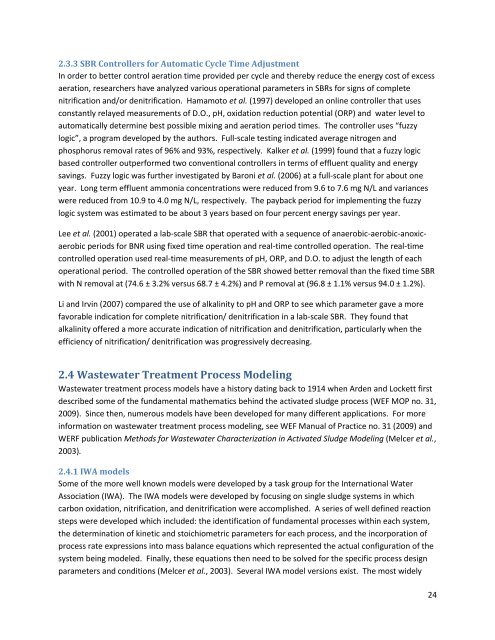E-Andrew Sindt Creative Component S11.pdf
E-Andrew Sindt Creative Component S11.pdf
E-Andrew Sindt Creative Component S11.pdf
Create successful ePaper yourself
Turn your PDF publications into a flip-book with our unique Google optimized e-Paper software.
2.3.3 SBR Controllers for Automatic Cycle Time AdjustmentIn order to better control aeration time provided per cycle and thereby reduce the energy cost of excessaeration, researchers have analyzed various operational parameters in SBRs for signs of completenitrification and/or denitrification. Hamamoto et al. (1997) developed an online controller that usesconstantly relayed measurements of D.O., pH, oxidation reduction potential (ORP) and water level toautomatically determine best possible mixing and aeration period times. The controller uses “fuzzylogic”, a program developed by the authors. Full-scale testing indicated average nitrogen andphosphorus removal rates of 96% and 93%, respectively. Kalker et al. (1999) found that a fuzzy logicbased controller outperformed two conventional controllers in terms of effluent quality and energysavings. Fuzzy logic was further investigated by Baroni et al. (2006) at a full-scale plant for about oneyear. Long term effluent ammonia concentrations were reduced from 9.6 to 7.6 mg N/L and varianceswere reduced from 10.9 to 4.0 mg N/L, respectively. The payback period for implementing the fuzzylogic system was estimated to be about 3 years based on four percent energy savings per year.Lee et al. (2001) operated a lab-scale SBR that operated with a sequence of anaerobic-aerobic-anoxicaerobicperiods for BNR using fixed time operation and real-time controlled operation. The real-timecontrolled operation used real-time measurements of pH, ORP, and D.O. to adjust the length of eachoperational period. The controlled operation of the SBR showed better removal than the fixed time SBRwith N removal at (74.6 ± 3.2% versus 68.7 ± 4.2%) and P removal at (96.8 ± 1.1% versus 94.0 ± 1.2%).Li and Irvin (2007) compared the use of alkalinity to pH and ORP to see which parameter gave a morefavorable indication for complete nitrification/ denitrification in a lab-scale SBR. They found thatalkalinity offered a more accurate indication of nitrification and denitrification, particularly when theefficiency of nitrification/ denitrification was progressively decreasing.2.4 Wastewater Treatment Process ModelingWastewater treatment process models have a history dating back to 1914 when Arden and Lockett firstdescribed some of the fundamental mathematics behind the activated sludge process (WEF MOP no. 31,2009). Since then, numerous models have been developed for many different applications. For moreinformation on wastewater treatment process modeling, see WEF Manual of Practice no. 31 (2009) andWERF publication Methods for Wastewater Characterization in Activated Sludge Modeling (Melcer et al.,2003).2.4.1 IWA modelsSome of the more well known models were developed by a task group for the International WaterAssociation (IWA). The IWA models were developed by focusing on single sludge systems in whichcarbon oxidation, nitrification, and denitrification were accomplished. A series of well defined reactionsteps were developed which included: the identification of fundamental processes within each system,the determination of kinetic and stoichiometric parameters for each process, and the incorporation ofprocess rate expressions into mass balance equations which represented the actual configuration of thesystem being modeled. Finally, these equations then need to be solved for the specific process designparameters and conditions (Melcer et al., 2003). Several IWA model versions exist. The most widely24
















